Violations (like double-parking) block bus lanes and reduce transit reliability — a big concern for the MTA and city planners.
General Overview of ACE Violations Dataset
What are the patterns of exempt violations across different times of day or week?

Exempt violations follow a bimodal pattern, peaking around 7 AM and 2 PM.
The early morning spike likely reflects buses navigating congested streets during commuter rush hours, while the afternoon peak may align with school dismissals, shift changes, and increased delivery activity.
These time-specific surges highlight potential pressure points for traffic enforcement and service reliability within the CBD.

Most exempt violations occur on weekdays, totaling around 13,000 compared to about 5,000 on weekends.
This weekday concentration reflects heavier bus and commercial activity in the CBD during standard work hours, suggesting that traffic management challenges are closely tied to weekday commuting and delivery patterns rather than weekend events.
Statistical Analysis of ACE Dataset
Some vehicles stopped in violation are exempt from fines due to business reasons. Do exempt vehicles and non-exempt vehicles have different patterns in their violation counts?
Mann-Whitney U Test
Null Hypothesis (H₀): The distributions of exempt and non-exempt violation counts are the same.
Alternative Hypothesis (H₁): The distributions of exempt and non-exempt violation counts are different.
Results:
- Test Statistic: 697,899,458.0
- p-value: < 0.001
Conclusion: Reject H₀ → Exempt vehicles' violation patterns are statistically different from those of non-exempt vehicles.
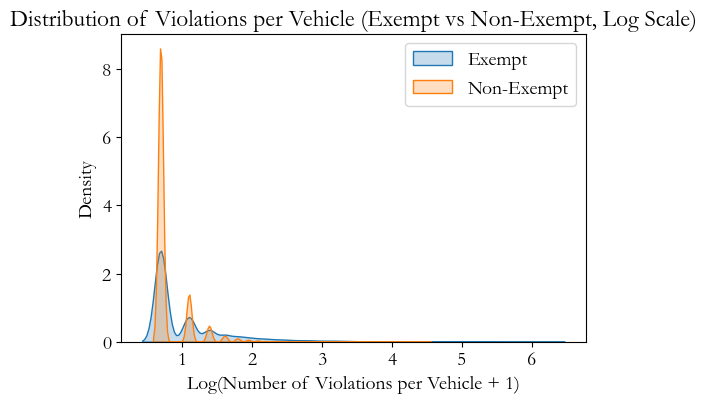
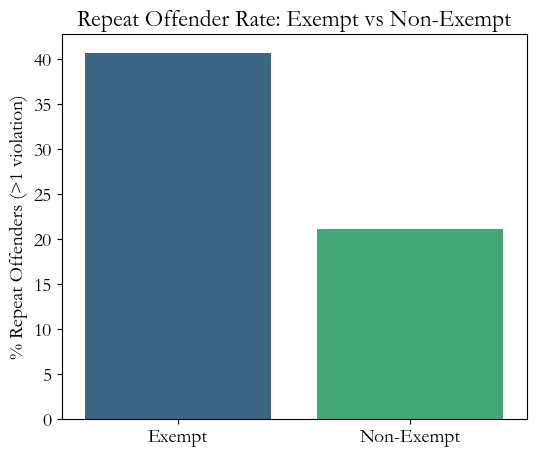
Mann–Whitney U Test with Cliff's Delta Effect Size
Exempt vehicles have a statistically higher rate of repeat violations than non-exempt vehicles (p < 0.001).
The effect size is small-to-moderate (Cliff's Delta = 0.22), indicating that exempt vehicles are somewhat more likely to repeatedly offend, though the difference is not dramatic.
Conclusion: This indicates that enforcement should focus on repeat offenders among exempt vehicles, while the moderate difference suggests that wide-scale policy changes may not be required.
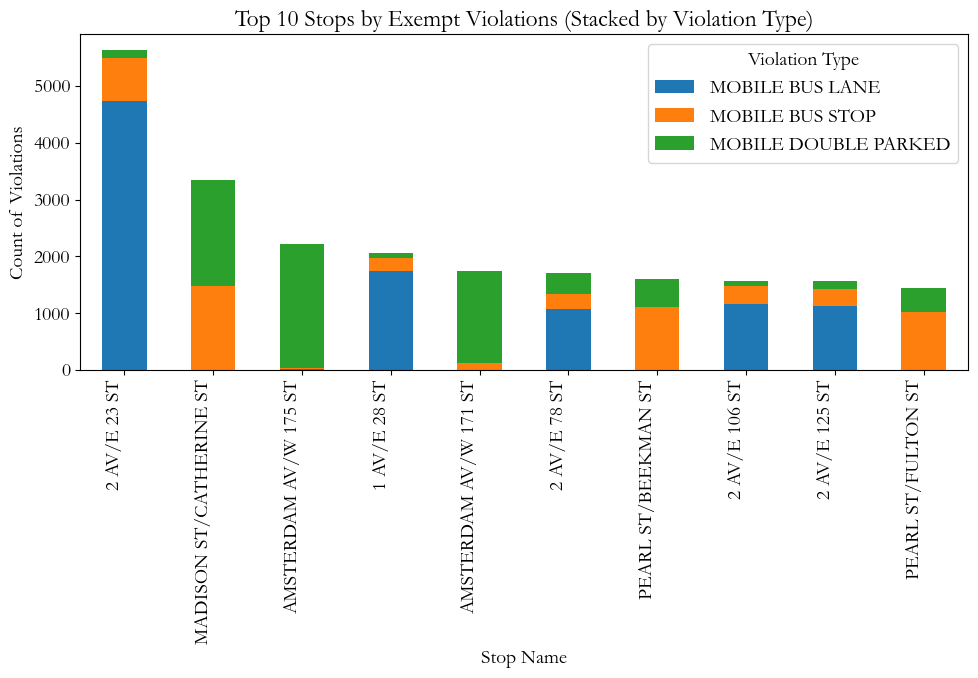
Chi-Square Test of Violation Types by Stop
Null Hypothesis (H₀): Violation types are randomly distributed across stops.
Alternative Hypothesis (H₁): Some stop/violation-type combinations occur more frequently than expected by chance.
Results:
- Chi-square statistic: 59,906.15
- p-value: < 0.001
Conclusion: We reject H₀. Exempt violations are concentrated at specific stops and for certain violation types. This suggests that enforcement resources and fleet management strategies could be optimized by focusing on high-risk stops and common violation types, improving efficiency and reducing repeat offenses.
Assessing the Impact of Street Events on Exempt Violations
- On average, there are slightly fewer exempt violations during events compared to nearby non-event days (Δ = -0.10)
- Most permitted events (block parties, film shoots, athletic races, etc.) don't disrupt traffic enough to trigger widespread exempt violations.
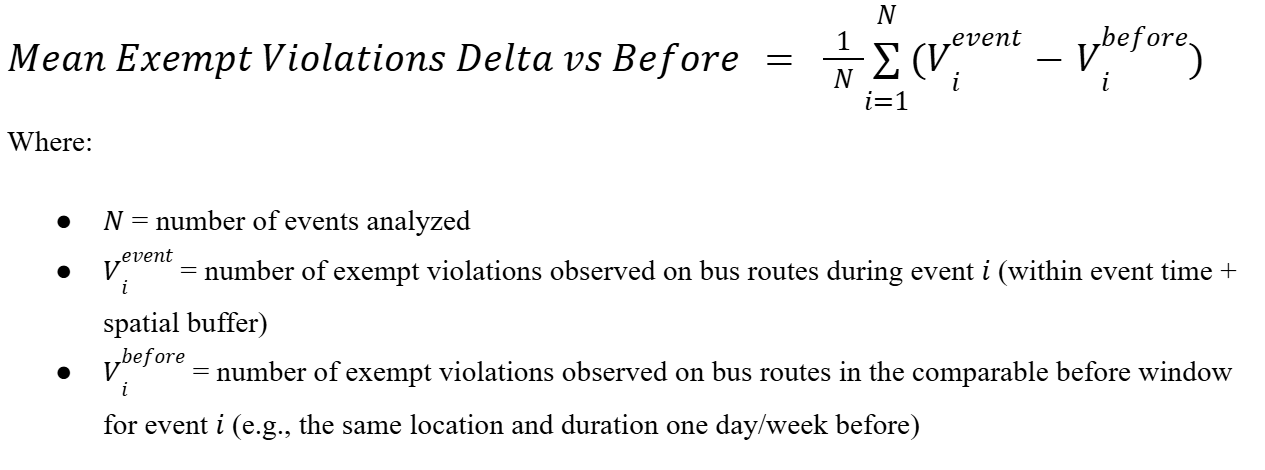
What matters is the event type…
(Full Street Closure + Curb Lane Closure)
→ 689 events (1-day, 2024)
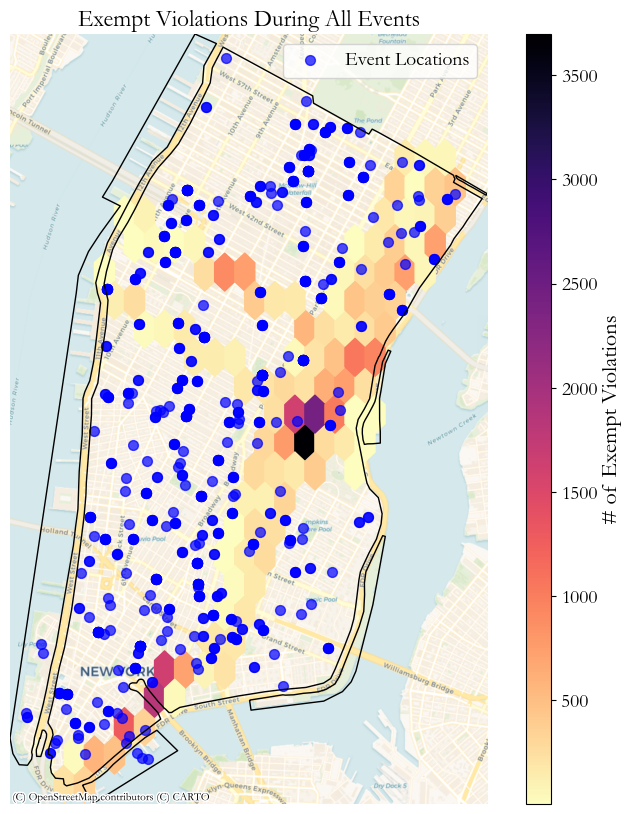
Full closures produce 4× more violations per event and account for ~44% of all violations, despite being just ~10% of events.
The type of event matters — full closures are the primary driver of double-parking behavior.
(Full Street Closure)
→ 70 events (1-day, 2024)
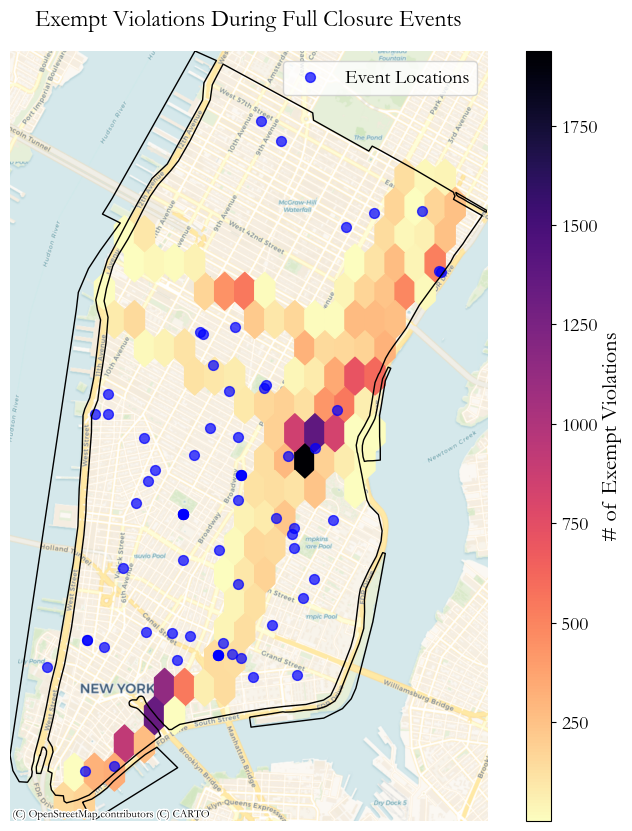
Repeat violators are 5× more common during full closures.
This suggests that a small group of vehicles disproportionately drive the problem.
Recommendations
Implement coordination between DOT & NYPD to adjust bus routes or add temporary loading zones near full closures, reducing double-parking hotspots and improving bus performance in the CBD.
Bus Speed Performance
.png)
.png)
ACE Violations
.png)
.png)
Bus Wait Performance
.png)
Correlation Matrix
.png)
Correlation Matrix
Event Impacts
Analysis of consistent events across both years, measuring impact against baseline conditions from the month prior to each event. The previous month is a month that had no events that had street closure in it.
Case Study: Chanel Artists Awards Dinner
Location: Thomas Street between West Broadway and Church Street
Affected Routes: M55, M20
.png)
.png)
High-Impact Event Example (2024)
Location: West 56th Street between 9th Avenue and 10th Avenue
Affected Routes: M31, M11, M12, M57
| Route | Baseline (mph) | Event (mph) | Change (%) | Impact |
|---|---|---|---|---|
| M12 | 6.16 | 6.67 | -7.64% | HIGH |
| M11 | 6.23 | 6.50 | -4.15% | MEDIUM |
| M57 | 4.86 | 4.94 | -1.55% | LOW |
| M31 | 5.18 | 5.22 | -0.88% | LOW |
Positive Impact Event Example (2024)
Location: West 30th Street between 7th Avenue and Avenue of the Americas
Affected Routes: M20, M7
| Route | Baseline (mph) | Event (mph) | Change (%) | Impact |
|---|---|---|---|---|
| M20 | 6.02 | 6.10 | +1.27% | LOW |
| M7 | 7.02 | 7.01 | -0.21% | LOW |
Not all street events negatively impact bus performance. Strategic event placement can improve traffic flow.
Recommendations
Develop a system to monitor the impacts of events using bus performance and street closure permits, to better decide where to allow street events that close one or more streets, promoting improved bus performance in Manhattan's Central Business District.